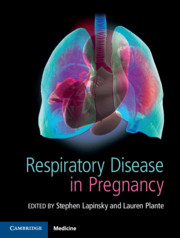Book contents
- Respiratory Disease in Pregnancy
- Respiratory Disease in Pregnancy
- Copyright page
- Contents
- Contributors
- Section 1 The Basics: for the Obstetrician
- Section 2 The Basics: for the Non-Obstetrician
- Section 3 Pulmonary Conditions Not Specific to Pregnancy
- Section 4 Pulmonary Conditions Related to Pregnancy
- 16 Dyspnoea of Pregnancy
- 17 Amniotic Fluid Embolism Syndrome
- 18 Pregnancy-Associated Pulmonary Oedema
- Section 5 Other Pulmonary Issues in Pregnancy
- Index
- References
17 - Amniotic Fluid Embolism Syndrome
from Section 4 - Pulmonary Conditions Related to Pregnancy
Published online by Cambridge University Press: 14 April 2020
- Respiratory Disease in Pregnancy
- Respiratory Disease in Pregnancy
- Copyright page
- Contents
- Contributors
- Section 1 The Basics: for the Obstetrician
- Section 2 The Basics: for the Non-Obstetrician
- Section 3 Pulmonary Conditions Not Specific to Pregnancy
- Section 4 Pulmonary Conditions Related to Pregnancy
- 16 Dyspnoea of Pregnancy
- 17 Amniotic Fluid Embolism Syndrome
- 18 Pregnancy-Associated Pulmonary Oedema
- Section 5 Other Pulmonary Issues in Pregnancy
- Index
- References
Summary
Amniotic fluid embolism syndrome (AFES) is one of the most devastating and catastrophic events unique to pregnancy that can occur during gestation, during labour and delivery, or in the immediate post-partum period. It is a frustrating and complex disease for the practitioner since there is significant variability in its clinical presentation. The incidence and frequency of the disease are also variable because of the lack of firm and established diagnostic criteria.
- Type
- Chapter
- Information
- Respiratory Disease in Pregnancy , pp. 163 - 170Publisher: Cambridge University PressPrint publication year: 2020
References
- 2
- Cited by



